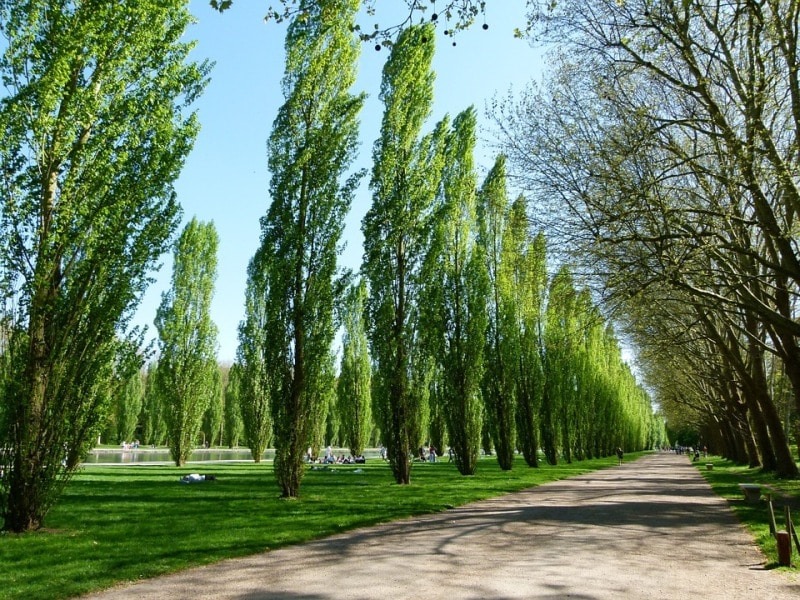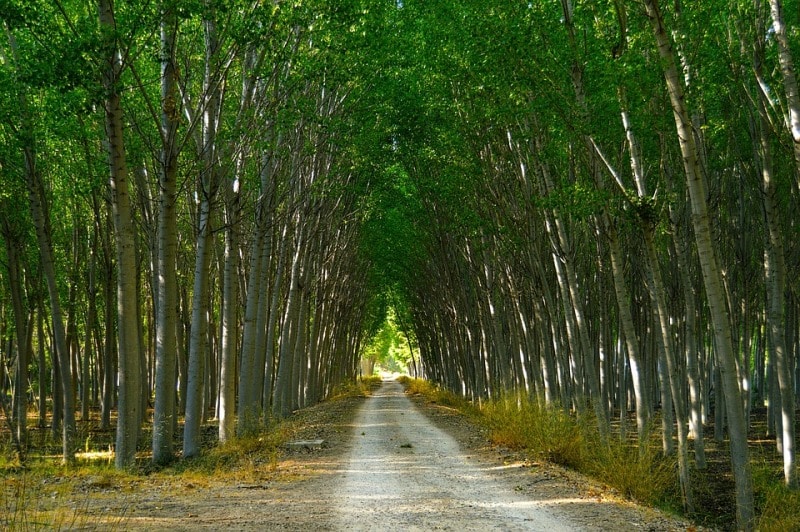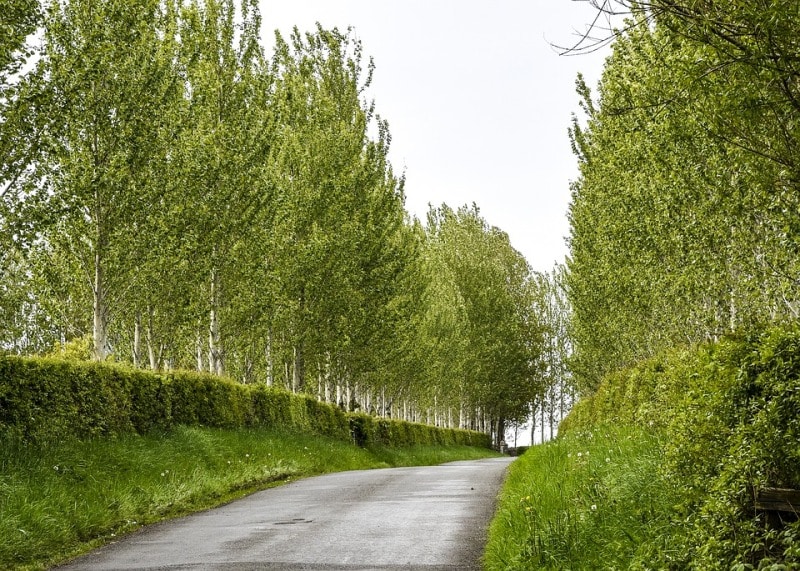Poplar tree plantation – A step by step guide
Growing Poplar trees for profit is a wise decision. Before getting into commercial hybrid poplar tree cultivation, you must have enough knowledge on the plantation of the Poplar tree and other cultural practices. Why wait..here we go!.
The Poplar tree is a deciduous tree and belongs to a family of Salicaceae. These trees are the fastest growing tree under ideal climatic conditions. Poplars wood and bark are mainly used for making plywood, boards, matchsticks, also for making sports good and pencil. Poplar trees are rapid-growing but relatively short-lived trees. In India, Poplar plant growing up to the height of 85 feet or above within life span of 5 to 7 years. Major poplar producing states in India in Haryana, Punjab, Uttarakhand, Uttar Pradesh, Himachal Pradesh, Jammu & Kashmir, Arunachal Pradesh, and West Bengal.

Poplar trees are developed as ornamental, landscaping trees, with numerous cultivars produced and used. These trees have the advantage of growing very large and quickly. Commercial propagation is very easy as most Poplars take root readily from cuttings.
Identification of Poplar tree:
Leaves aside, tree bark may provide some clues to identity Poplar trees. For example, the white Poplar tree has grayish-white color diamond-shaped marks on its bark as a young tree. These turn black color as the tree ages. The black Poplar tree has a dark grayish-brown color bark and clusters of upright branches. A young balsam poplar tree has a greenish to reddish-brown bark, which turns gray color as it ages. Moreover, if you notice a sweet fragrance from a poplar tree’s opening buds, it is likely to be a balsam poplar.
Common names of Poplar trees
Some of the common names of Poplar trees can be given below;
Common names of Poplar trees are Balsam Poplars, Bigleaf Poplars, Black Poplars, White Poplars, Mexican Poplars, Necklace Poplars, and Subtropical Poplars. The Botanical name for Poplar is Populus, and all species of Poplar belong to the Populus genus group.
Uses of Poplar:
Here we will discuss some of the uses of Poplar tree;
- It’s used mainly for pallets, crates, upholstered furniture frames, paper (pulpwood), and plywood. Poplar veneer is used for a variety of applications these are either dyed in various colors, or on hidden undersides of veneered panels to counteract the pull of the glue on an exposed part that has been veneered with another, more decorative wood species.
- Due to its relatively modest price point, Poplar is a great option for industrial type uses.
- Over the years Poplar has developed in popularity in the manufacturing of picture frames and this continues to be common use.
- The United States Forestry Service (USFS) notes that Poplar has high cellulose and low lignin, or fiber, content, which means it can be used for paper as fine as tissue, as refined as formal letterhead or as tough as kraft.
- The Poplar tree is used in Art and literature.
- Poplar tree logs are mainly used for biocontrol of termites in crops.
- Poplar tree has always been used as a material for upholstered lumber. It is not generally used in fine furniture because of its color variation but it is great for framing and support.
- Generally, the Poplar tree is also used for making matches, pallets, cheap plywood and boxes.
- The Poplar tree is often used for ceiling molding and trim. It is known to be stable and takes paint and stain well. It is also regularly found in longer lengths since its logs can be harvested in longer increments which make it ideal for this type of application.
- Poplar wood is used in the manufacture of musical instruments such as guitars, drums, and violas.
You may be interested to read Teak Wood Farming, Planting, Care, Harvesting.
Types of Poplar trees
Now let us see different types of Poplar trees;
Different types of Poplar trees consist of the white poplar, the cottonwood, and the black poplar. Another Poplar is the Lombardy poplar, which is a male clone of a tree developed in the Lombardy region of Italy. Aspens are other kinds of Poplars.
- The white Poplar tree is native to central and Western Europe and is grown as an ornamental in parks and gardens. White poplar leaves are covered with white down before they open. Then, Poplar leaves turn a dark, glossy green above and pure white beneath. The bark is white or gray and smooth.
- The cottonwood Poplar grows near rivers and is grown for its timber and valued for its use as a shade tree. It has triangular shaped serrated leaves. It’s a fast-growing tree, but it does not live very much longer.
- The true black poplar is native to Europe, North Africa, and eastern Asia, but its cultivars have been planted commonly. The Lombardy poplar is one type of black poplar. This Poplar is prominent for its columnar habit. Its bark is gray, fluted and can be cracked. It might bear shoots. The one disadvantage of Lombardy poplars is that they, too, don’t live long.
- The quaking aspen grows large regions of North America. The flattened stems are what because of the round, toothed leaves to quake in the wind.
Climate requirement for plantation of Poplar tree:
Before the plantation of Poplar tree, you must know the suitable agro-climatic conditions. This Poplar tree can grow generally in temperate climatic conditions. Poplar tree can thrive optimum in between temperature range of 5°C to 45°C areas in India. Poplar tree requires straight sunlight and sufficient moisture substance in the soil. The Frost conditions are not well for the improved growth of the Poplar tree.
Soil requirement for plantation of Poplar tree:
Avoid alkaline and saline soils for Poplar growth cultivation. It gives the best effect when grown on fertile loamy soils rich in organic matter. For Poplar cultivation, the ideal pH level of soil should be between 5.8 to 8.5.
Propagation of Poplar tree farming in India
The Poplar trees are developed from Kalam or softwood and hardwood cuttings method. But in this process Poplar tree cannot thrive well. So, you must take the young plants from nursery and plantation them in the land.
Sowing:
Time of sowing: January and February month is the best time for transplanting of Poplar seedling. And, also planting can be done from 15th Feb to 10th March.
The spacing of Poplar plants: Use spacing of 5 x 5 m (Plant population182 plant per acre) or 5 m x 4 m or 6 m x 2 m (396 plants per acre) or 5 m x 2 m (476 plants per acre).
Sowing Depth: For planting, dug 1-meter pit and then plant a seedling in the pit. Topsoil must be mixed with well-decomposed cow dung@ 2 kg, MOP@25gm, and SSP@50gm.
Method of sowing: Poplar is sown by direct sowing or by transplanting method.
Seed
Seed Treatment: To protect seedling from pest and disease attack, before planting young plant should be treated with a fungicide. Pruned thick and damaged roots of seedling before treatment. Treat seedling with Chlorpyriphos@250ml/100Ltrs of water for 10 to 15 min. After this, place the seedling in Emisan 6@200gm/100Ltr for 20 minutes. Some information about seed treatment for growing Poplar trees;
- You must keep the young plants in chemicals and fungicides in a nursery before moving on to the main field to prevent any pests and diseases.
- You should soak young plant one meter from roots in chlorpyriphos (250ml in 100 liters of water) for 10 to 12 minutes to avert any pest attack.
- If you want to avoid any fungal disease from Seedlings then you must be placed young plants in Emisan -6 (200 grams in 100 liters of water) for 20 to 22 minutes.
You may also check Brinjal Farming Profit, Cost.
Poplar tree Intercropping:
For the first two years of planting, intercrops can be done. It will help the farmer to earn income through the initial years of Poplar cultivation. You can be planting the poplar tree in the farm or field and cultivate on the boundary of the farm. In Poplar tree farming farmer can utilize the inner free space for intercrops cultivation and obtain the extra income. Crops like sugarcane, turmeric, potato, tomato, coriander, and ginger can be taken as Poplar tree intercrops.
Planting of a Poplar tree
In the plantation of Poplar tree, planting time is important. If plants are not planted in the right time then planted could be 10% mortality. When you transfer seedlings from the nursery to major filed then directly placed in the storage pits which are filled with fresh water (2 to 3 days). Usually, you can start planting in January.
Poplar trees grow very big, very fast. Poplar root systems can extend more than 100 feet in search of water. Planting one close to houses or ceramic water pipes may effect in damaged foundations and cracked walls and pipes.
Irrigation requirement for Poplar tree plantation:
During the first year, apply light and frequent irrigation with an interval of seven days till the onset of monsoon. In October-December apply two irrigation per month. In the second year, in winter season apply irrigation at an interval of 15 to 20 days and in summer apply irrigation at an interval of 7 days. In the third year and onwards, in summer season apply two irrigation per month.
Weed control in Poplar tree plantation:
Removes weed during the initial years of Poplar crop. Once a Poplar tree is developed, minimum weeds developed under shade.
If you do not control the extra weed from the field then they influence the Poplar tree growth. You can apply the Herbicides on the land for control the extra weed around the whole Poplar tree. You should control the weed during the 1 to 2 years after planting. After the Poplar tree well grown you not require to control the weed because it is automatically controlled by the shade of the trees.
Poplar tree plant protection:

Pest and their control:
The following are some of the pests that are found in Poplar trees;
Termites: If infestation is observed, to control apply Chlorpyriphos@1.5 Liter per acre.
Stem Borer: If infestation is observed, to control apply Phorate 10G@5kg/acre up to the second year of plantation or inject Kerosene@2 to 5ml per hole.
Mites: If infestation is observed, to control this pest to take spray of Metasystox@2ml/Ltr of water. Repeat the spray with an interval of 15 days.
Leaf Defoliators: Its infestation is observed in July. To control take spray of Chlorpyriphos 200 ml + Cypermethrin@80 ml per acre.
Leaf-feeding Caterpillars: All species of poplars are affected by sort of leaf-feeding caterpillar. Larva feed on the buds or the leaves causing a lacy form. Infestations generally aren’t fatal, but several successive years of attack can weaken a tree enough to kill it. Insecticides can be helpful to treat infestations.
You may check A Step by Step Guide for Goat Farming in India.
Diseases of Poplar trees
The following are some of the diseases that are found in Poplar trees;
Wet wood or Slime Flux: A bacterium takes hold in the heartwood and causes abnormally very high sap pressure. Fermented sap (or flux) is forced out of wounds in the tree. The sap is sour-smelling and oozes down the side of the tree, causing unsightly gray streaks when dried. The wounds generally will not heal accurately and the condition can persist for many years. While there is no treatment for the disease, the streaking can sometimes be prevented by placing a small tube in the infected area thus, the flux drips away from the tree.
Canker and Dieback: Canker and dieback on poplars are caused by some different fungi. Lombardy poplars are particularly vulnerable. Dark sunken cankers form where the fungus enters a tree during wounds or cracks. These cankers can disrupt water and nutrient flow also, if it spreads to more than half of the diameter of the trunk, will probably kill the tree. Pruning off infected and removing severely infected trees can slow or even prevent spread. The best measure is to help the general health of the tree through regular fertilization and watering.
Harvesting of Poplars:
Clearcutting creates the conditions Poplars require to regenerate naturally. Depending on the site, you might harvest with patch cuts or strip cuts, though taking measures to protect wildlife dens, shorelines, and slopes. The whole-tree process, which removes the entire tree, is recommended because it leaves little debris on the site. Fine branches and other debris are often put during a roadside chipper and used for pulp.
The Poplar trees are developed from kalam or cuttings, harvested annually in January and February, and commercially available up to 15 November.
Regenerating Poplars:
Poplars are very easy and inexpensive to reproduce. When mature Poplars are harvested through clear-cutting, a dense carpet of new shoots known as coppice growth or suckers sprouts from the roots near the soil surface. The Poplar suckers develop rapidly into a new forest. In fact, they can make a pulpwood size in 20 to 30 years.
Varieties of Poplar trees in India:
In India, the Poplar is grown commercially by farmers, mostly in the Punjab region. Common Poplar varieties in India are;
- G48 (These type of Poplars grown in the plains of Punjab, Haryana, UP)
- w22 (grown in mountainous regions, for example, Himachal Pradesh, Pathankot, Jammu)
Poplar tree profits, yield and market price

Poplar yield depends on climate conditions, site quality, clone, age, spacing, and silvicultural conditions and treatments. Poplar yield estimates range from 1.25 to 8.61 dry tons per acre per year.
You may also be interested in Kadaknath Egg Production.
You can get the profit approximately 3600 to 4000 rupees per tree when poplar tree has 34 to 36 inches in girth or diameter; the height of a tree is 5 feet or 1.6 meters from ground level and 80 feet in height. The market value of the poplar tree mostly depends on the girth (diameter) of the tree.
If poplar tree cultivation is done on one-acre land so there are 225 plants and you will get about 1000 to 1250 quintals which give approximately about 5.25 to 6 lacs. In the local market, these poplar trees are much demanded. So, you can get the good returns from Poplar tree cultivation.
Some facts about Poplar trees:
Here we can discuss some facts about growing Poplar trees;
- Poplar trees can be found around the world and are recognized for their ability to grow very tall very quickly. Some results show Poplars can grow as much as 8 feet in a single year.
- The black Poplar tree is a majestic tree that can grow up to 30 meters tall and live for as long as 200 years.
- Lombardy poplar trees are not evergreens, but they continue to give great wind blockage and privacy throughout the year.
- This species of a Poplar tree is a popular shade tree. It takes about 5 years to grow poplars to harvestable height, making them popular in industrial applications as well (lumber, etc.). Hybrid poplars can put on 10 feet a year.
- For the best results, space Poplar planting holes four feet apart in a single row. However, if you’re planting two staggered rows of trees and a double row offers more wind protection. Space the planting holes 6 feet apart with six feet between rows.
- For watering Poplar trees, although the Poplar tree is relatively adaptable, it does need adequate watering. Poplars produce best along riverbeds and water-rich regions.
- For proper Poplar tree growth, don’t exceed more than 4 inches of mulch.
- The Poplar trees are invasive. Although not on California’s invasive species list, poplar trees have some of the important characteristics of an invasive species. They are; Poplar trees are fast-growing and their roots send up suckers that form new poplar trees in all directions. Suckers can sprout from stumps, fallen branches, and cut trees as well as from Poplar roots.
- The black poplar tree is a broadleaf deciduous tree native to the UK and Europe. And, black poplar is the most endangered native timber tree in Britain.
- The Poplar tree is not considered a messy tree other than when the leaves drop in the fall. This tree’s wood is somewhat soft. The Poplar tree is a fast-growing tree and among our customers’ favorites as far as shade trees.
- To control Poplar trees or to girdle a poplar, cut a groove into the tree’s trunk all the way around, penetrating at least 1/2 inch on small trees and 1 1/2 inches on full-grown trees. You want to cut through to the sticky layer, or cambium, under the bark. Use an ax, saw, and chainsaw to make the cuts.
- Generally, Poplar is a hardwood tree that produces softwood when compared to other hardwood trees. The hardness of Poplar tree is about on par with that of pine or cedar, but the cellular structure gives it a much finer grain and more pleasing look than the more coarsely grained softwoods.
- Oak is stronger than Poplar. Oak is a harder, denser hardwood than Poplar tree, which is also classified as a hardwood.
That’s all folks about poplar tree plantation methods, profit details.
You may be interested to read the Growing Organic Tomatoes on the Terrace.
GOOD INFORMATION.
THANKS;
Thanks for all very good information, appreciate your hard work in collating details.
Thanks Sir, Very Important Information Thank you
Thank you so much. For your valuable information
It is the kind of information I was looking for.Thanks a lot.
Thanks for very good information and detail. we look for the seed try to planting the poplar,
Could you share for the supplier and we can purchase?
Regards